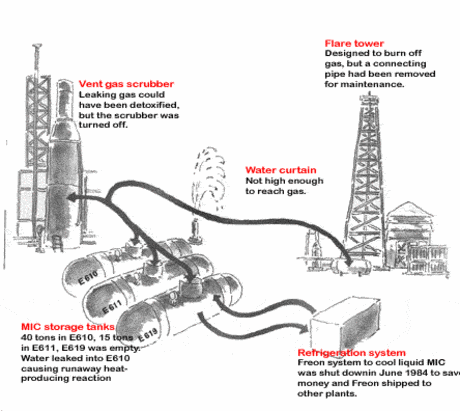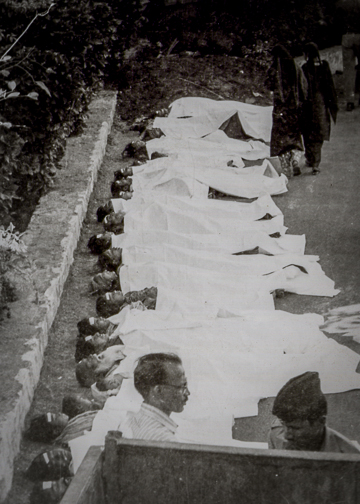
Although MIC is a particularly reactive and deadly gas, the Union Carbide plant’s safety systems were allowed to fall into disrepair. Between 1983 and 1984, the safety manuals were re-written to permit switching off the refrigeration unit and shutting down the vent gas scrubber when the plant was not in operation. Cost-cutting measures directed by the Danbury Headquarters of Union Carbide included reducing the MIC plant crew from 12 to 6. In the control room, there was only 1 operator to monitor 70+ panels. Safety training was cut from 6 months to 15 days. On the night of the deadly MIC leak, none of the safety systems designed to prevent a leak - six in all - were operational, and the plant siren had been turned off, a major cost-cutting effort (including a reduction of 335 men) was undertaken in 1983, saving the company $1.25 million that year.
On the night of December 2nd and 3rd, 1984, a Union Carbide plant in Bhopal, India, began leaking 27 tons of the deadly gas methyl isocyanate. Regular maintenance had fallen into such disrepair that on the night of December 2nd, when an employee was flushing a corroded pipe, multiple stopcocks failed and allowed water to flow freely into the largest tank of MIC. Exposure to this water soon led to an uncontrolled reaction; the tank was blown out of its concrete sarcophagus and spewed a deadly cloud of MIC, hydrogen cyanide, mono methyl amine and other chemicals that hugged the ground. Blown by the prevailing winds, this cloud settled over much of Bhopal.

That Night:
Death came out of a clear sky. Midnight, a cold wind blowing, the stars brilliant as they are in central India, even through the thin pall of cooking-fire smoke that hung above the city. Here and there, braziers were burning to warm those who were obliged to be out late. From the factory, which so many had learned to fear, a thin plume of white vapor began streaming from a high structure. Caught by the wind, it became a haze and blew downward to mix with smokes coming from somewhere nearer to the ground. A dense fog formed. Nudged by the wind, it rolled across the road and into the alleys on the other side. Here the houses were packed close, ill-built, with badly fitting doors and windows. Those within were roused in darkness to the sound of screams with the gases already in their eyes, noses and throats. It burnt terribly and felt like fire.
When dawn broke over the city, thousands of bodies lay in heaps in the streets. Even far from the factory, near the lake, at Rani Hira Pati ka Mahal the ground was so thick with dead that one could not avoid treading on them. The army dumped hundreds of bodies in the surrounding forests and the Betwa river was so choked with corpses that they formed log-jams against the arches of bridges. Families and entire communities were wiped out, leaving no one to identify them.”
Poison gas that leaked from a Union Carbide factory, killed thousands. How many thousands, no one knows. Carbide says 3,800. Municipal workers, who picked up bodies with their own hands, loading them onto trucks for burial in mass graves or to be burned on mass pyres, reckon they shifted at least 15,000 bodies. Survivors, basing their estimates on the number of shrouds sold in the city, conservatively claim about 8,000 died in the first week. The official death toll to date (local government figures) stands at more than 20,000. Such body counts become meaningless when you know that the dying has never stopped. Even now, twenty years later, at least one person per day dies in Bhopal from the injuries they sustained on that night.
More than 150,000 people were left severely disabled - of whom 22,000 have since died of their injuries - in a disaster now widely acknowledged as the world’s worst-ever industrial disaster.
Survivors Testimonials:

Remembers Aziza Sultan, a survivor: "At about 12.30 am I woke to the sound of my baby coughing badly. In the half light I saw that the room was filled with a white cloud. I heard a lot of people shouting. They were shouting 'run, run'. Then I started coughing with each breath seeming as if I was breathing in fire. My eyes were burning”.
Another survivor, Champa Devi Shukla, remembers that "It felt like somebody had filled our bodies up with red chillies, our eyes tears coming out, noses were watering, we had froth in our mouths. The coughing was so bad that people were writhing in pain. Some people just got up and ran in whatever they were wearing or even if they were wearing nothing at all. Somebody was running this way and somebody was running that way, some people were just running in their underclothes. People were only concerned as to how they would save their lives so they just ran.
"Those who fell were not picked up by anybody, they just kept falling, and were trampled on by other people. People climbed and scrambled over each other to save their lives – even cows were running and trying to save their lives and crushing people as they ran."
In those apocalyptic moments no one knew what was happening. People simply started dying in the most hideous ways. Some vomited uncontrollably, went into convulsions and fell dead. Others choked to death, drowning in their own body fluids. Many died in the stampedes through narrow gullies where street lamps burned a dim brown through clouds of gas. The force of the human torrent wrenched children's hands from their parents' grasp. Families were whirled apart," reported the Bhopal Medical Appeal in 1994.
"The poison cloud was so dense and searing that people were reduced to near blindness. As they gasped for breath its effects grew ever more suffocating. The gases burned the tissues of their eyes and lungs and attacked their nervous systems. People lost control of their bodies. Urine and feces ran down their legs. Women lost their unborn children as they ran, their wombs spontaneously opening in bloody abortion." According to Rashida Bi, a survivor who lost five gas-exposed family members to cancers, those who escaped with their lives “are the unlucky ones; the lucky ones are those who died on that night.”
